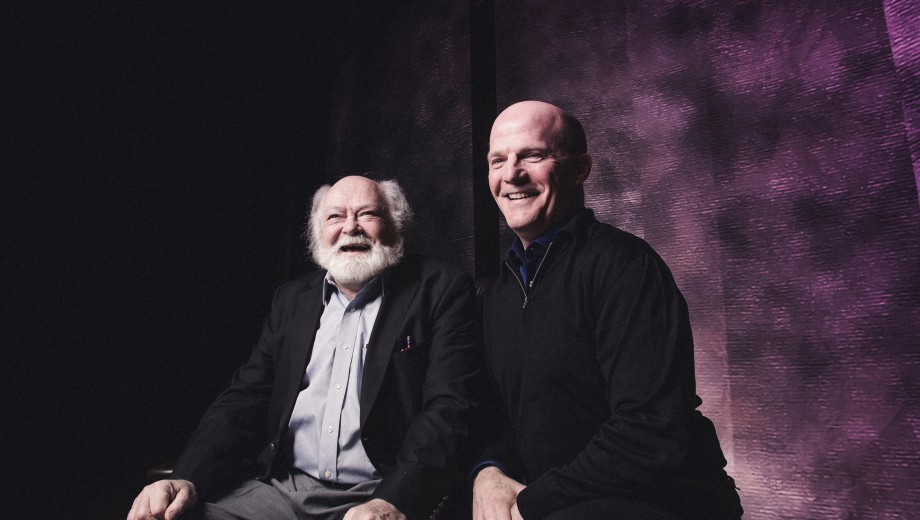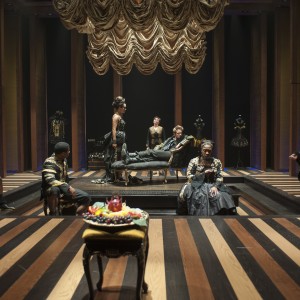Court Theatre is a mainstay of the Chicago theater scene, a company so dependable that in 2006 the Wall Street Journal dubbed it the most consistently excellent theater in America.
But Nicholas Rudall remembers when the campus company was so short of cash that he had to donate a fridge for theater staff to use. Rudall, a professor emeritus in Classics who was Court’s artistic director from 1971 to 1994, laughs at the memory. “That’s the way theater actually works,” he says of Court’s hardscrabble beginnings. “It comes from people with a passion for it and people willing to do anything for it.”
Court was the brainchild of University Theater director Marvin Phillips, who in 1955 wanted to capitalize on the popularity of outdoor summer theater.
That summer, a coalition of students, faculty, and community members performed three Molière plays on a small Elizabethan stage under the elms of Hutchinson Courtyard. The plays were translated by French professor Richard d’Anjou—an early example of the collaboration between Court and UChicago scholars that has since become a hallmark.
“The University of Chicago is . . . creating a new type of summer theatre,” Phillips wrote in a memo to University leaders after the company’s first season. “Instead of following a star system or relying on the production of last year’s Broadway's successes, we are presenting only examples of the world’s great dramatic literature in the best tradition of the academic theatre.”
Today, Court’s Center for Classic Theatre taps the expertise of faculty to translate and adapt plays and advise the actors and production team. In 2011 Travis Jackson, associate professor in Music, advised Court’s artistic director Charles Newell on the score for his Jeff Award–winning production of Porgy and Bess. Last year a conversation between Newell and Judith Zeitlin, professor in East Asian Languages and Civilizations, resulted in a daring revival of David Henry Hwang’s M. Butterfly.
Court’s emphasis on classic theater and willingness to stage difficult modern works were welcome additions to Chicago’s still-emergent theater scene in the 1960s and 1970s, says Rudall. Back then, “you couldn’t look in the newspaper and decide to go see an Ibsen play or even Shakespeare.”
Court and its directors embraced the challenge of producing the works of Brecht and Shaw and Euripides. Rudall’s background in classics proved to be an asset. “Even when I was teaching Greek tragedies in Greek, I was always thinking of them as theater, not just as literature,” he explains. “Both sides have touched each other.”
Although Court performed serious plays, the company still liked to enjoy themselves at the theater. A 1969 memo reminded performers that “DRINKING INTOXICATING LIQUORS in and around Mandel Hall is against a University law. Abuses of it have cost us a dress rehearsal once, in the old days, so never again.”
Productions earned strong reviews that attracted talented actors and technical staff from across the country. A young Kevin Kline made his Chicago debut in ’Tis Pity She’s a Whore (directed by Rudall) in 1968.
In the mid-1970s, University of Chicago president Edward Levi, LAB’28, PhB’32, JD’35, asked Rudall to lead Court’s transformation into a year-round professional company. It was, Rudall believes, part of Levi’s effort to make Hyde Park more attractive to faculty and students.
Rudall and his colleagues raised funds for a 250-seat theater to be Court’s permanent home. Completed in 1981, the Abelson Auditorium now brings in 35,000 patrons annually to see Court productions. Under Newell’s leadership, partnerships with faculty remain a tradition: Court will use Rudall’s translation of Euripides’ Iphigenia in Aulis for the current 60th season. It’s a fitting tribute to the company’s origins as it steps toward the future.



Comments
Dick Danjou was not a faculty
Dick Danjou was not a faculty member. Court theatre members founded a theatre in Hyde Park, The Last Stage, and presented the John Ford play ('Tis Pity) in the early 60s.
Early Court Theater History
The early history of Court Theater, pre-Nick Rudell, is well worth researching and reporting on. In the early '60's my late husband Robert Strang co-produced with Bob Benedetti many memorable plays under the Hutchinson Court elms, climbing the trees to hang the stage lights. Shakespeare, Moliere, and Sopocles to be sure, but also the antic modern comedy Pantaglaze, by Belgian Michel de Ghelderode. In addition, Court featured music: lots of jazz and folk. The classic Canadian folk duo Ian and Sylvia made their US debut under those elms. And did you know the notorious spy Rick Ames worked tech at Court for several years? Lots still to resurrect about Court Theater, and plenty of the actors, directors, and costume designers are still with us.
Tis Pity Indeed
I too performed in the 1968 Court Theatre production of Tis Pity, though merely as one of the cutthroats ("Banditti") commanded by Vasques (Nick Ruddall). I didn't know it, but I was being schooled in the arts of political science, and should have abandoned the English Dept. for those greener pastures (but, sadly, didn't). That summer was memorable for the fetid smell of dead alewives in Lake Michigan (courtesy of a kill-off resulting from lamprey eels preying on the lake trout) and the rancid cow's heart Kevin Kline had to wield after he murdered his sister/lover Annabella (my secret heart throb, the scintillating Diane Rudall). It was a very hot summer in every sense, and a great time to go north to Stratford, Ontario to see Martha Henry (also scintillating) and Douglas Rain in the annual Shakespeare festival -- and miss the horrid riots in the Democratic Convention. That's what I and most of the veteran Court Theatre company did. Great time. By the way, what ever happened to Kevin Kline? Don't see him much around here in St. Louis any more. And where, pray tell, is his very blonde compadre at the time, Sigrid (still another scintillating young lady who accompanied Kevin up from Indiana University -- I said it was a great summer)?
Alewives correction
Amending my previous posting: The great alewives dieoff the lake occurred in 1967, not '68. Memory plays tricks, I guess. It's natural, in retrospect, to attribute any disaster in the late 1960's to the wonderful year of 1968. Another fact conducive to this confusion: I acted in the Court Theatre in 1967 as well.
Old days at Court 1960's
I too portformed at Court theater with Jim O'Reilly in King Lear,
Marry Wives of Windor, Last Stage, etc. Are there any old photos of those shows around?